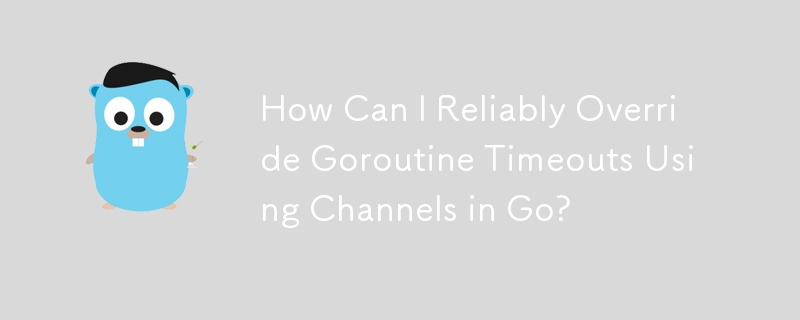 Backend Development
Backend Development
 Golang
Golang
 How Can I Reliably Override Goroutine Timeouts Using Channels in Go?
How Can I Reliably Override Goroutine Timeouts Using Channels in Go?
How Can I Reliably Override Goroutine Timeouts Using Channels in Go?

Overriding Timeouts in Goroutines with Channels
In Golang, when using goroutines and channels for asynchronous tasks, it's possible to specify timeouts to ensure that operations don't hang indefinitely. However, in certain scenarios, the timeout case may not be executed as expected.
Consider the following code snippet:
package main
import (
"fmt"
"time"
)
func main() {
c1 := make(chan int, 1) // Buffered channel with capacity 1
go func() {
for {
time.Sleep(1500 * time.Millisecond) // Sleep for 1.5 seconds
c1 <- 10 // Send value to channel
}
}()
go func() {
for {
select {
case i := <-c1:
fmt.Println(i)
case <-time.After(2000 * time.Millisecond):
fmt.Println("TIMEOUT") // Not executed
}
}
}()
fmt.Scanln() // Wait for user input
}In this code, we have two goroutines: one that periodically sends a value to a buffered channel c1, and another that selects from c1 with a timeout of 2 seconds. However, the timeout case ("TIMEOUT") is never printed.
The reason for this lies in the nature of buffered channels and the way timeouts are handled. In this scenario, the goroutine that sends values to c1 will continually refill the channel every 1.5 seconds. As a result, the select statement in the second goroutine will always receive a value from c1 before the timeout expires.
To fix this issue and ensure that the timeout case is executed, we need to create the timeout channel outside the select loop. This prevents it from being discarded each time a value is received from c1:
timeout := time.After(2000 * time.Millisecond) // Create timeout channel only once
for {
select {
case i := <-c1:
fmt.Println(i)
case <-timeout:
fmt.Println("TIMEOUT")
}
}With this modification, the select statement will continue to select from c1, but if no value is received within the specified timeout, the "TIMEOUT" case will be executed.
The above is the detailed content of How Can I Reliably Override Goroutine Timeouts Using Channels in Go?. For more information, please follow other related articles on the PHP Chinese website!

Hot AI Tools

Undresser.AI Undress
AI-powered app for creating realistic nude photos

AI Clothes Remover
Online AI tool for removing clothes from photos.

Undress AI Tool
Undress images for free

Clothoff.io
AI clothes remover

AI Hentai Generator
Generate AI Hentai for free.

Hot Article

Hot Tools

Notepad++7.3.1
Easy-to-use and free code editor

SublimeText3 Chinese version
Chinese version, very easy to use

Zend Studio 13.0.1
Powerful PHP integrated development environment

Dreamweaver CS6
Visual web development tools

SublimeText3 Mac version
God-level code editing software (SublimeText3)

Hot Topics
 1376
1376
 52
52
 What are the vulnerabilities of Debian OpenSSL
Apr 02, 2025 am 07:30 AM
What are the vulnerabilities of Debian OpenSSL
Apr 02, 2025 am 07:30 AM
OpenSSL, as an open source library widely used in secure communications, provides encryption algorithms, keys and certificate management functions. However, there are some known security vulnerabilities in its historical version, some of which are extremely harmful. This article will focus on common vulnerabilities and response measures for OpenSSL in Debian systems. DebianOpenSSL known vulnerabilities: OpenSSL has experienced several serious vulnerabilities, such as: Heart Bleeding Vulnerability (CVE-2014-0160): This vulnerability affects OpenSSL 1.0.1 to 1.0.1f and 1.0.2 to 1.0.2 beta versions. An attacker can use this vulnerability to unauthorized read sensitive information on the server, including encryption keys, etc.
 How do you use the pprof tool to analyze Go performance?
Mar 21, 2025 pm 06:37 PM
How do you use the pprof tool to analyze Go performance?
Mar 21, 2025 pm 06:37 PM
The article explains how to use the pprof tool for analyzing Go performance, including enabling profiling, collecting data, and identifying common bottlenecks like CPU and memory issues.Character count: 159
 How do you write unit tests in Go?
Mar 21, 2025 pm 06:34 PM
How do you write unit tests in Go?
Mar 21, 2025 pm 06:34 PM
The article discusses writing unit tests in Go, covering best practices, mocking techniques, and tools for efficient test management.
 What libraries are used for floating point number operations in Go?
Apr 02, 2025 pm 02:06 PM
What libraries are used for floating point number operations in Go?
Apr 02, 2025 pm 02:06 PM
The library used for floating-point number operation in Go language introduces how to ensure the accuracy is...
 What is the problem with Queue thread in Go's crawler Colly?
Apr 02, 2025 pm 02:09 PM
What is the problem with Queue thread in Go's crawler Colly?
Apr 02, 2025 pm 02:09 PM
Queue threading problem in Go crawler Colly explores the problem of using the Colly crawler library in Go language, developers often encounter problems with threads and request queues. �...
 How do you specify dependencies in your go.mod file?
Mar 27, 2025 pm 07:14 PM
How do you specify dependencies in your go.mod file?
Mar 27, 2025 pm 07:14 PM
The article discusses managing Go module dependencies via go.mod, covering specification, updates, and conflict resolution. It emphasizes best practices like semantic versioning and regular updates.
 How do you use table-driven tests in Go?
Mar 21, 2025 pm 06:35 PM
How do you use table-driven tests in Go?
Mar 21, 2025 pm 06:35 PM
The article discusses using table-driven tests in Go, a method that uses a table of test cases to test functions with multiple inputs and outcomes. It highlights benefits like improved readability, reduced duplication, scalability, consistency, and a
 Transforming from front-end to back-end development, is it more promising to learn Java or Golang?
Apr 02, 2025 am 09:12 AM
Transforming from front-end to back-end development, is it more promising to learn Java or Golang?
Apr 02, 2025 am 09:12 AM
Backend learning path: The exploration journey from front-end to back-end As a back-end beginner who transforms from front-end development, you already have the foundation of nodejs,...



